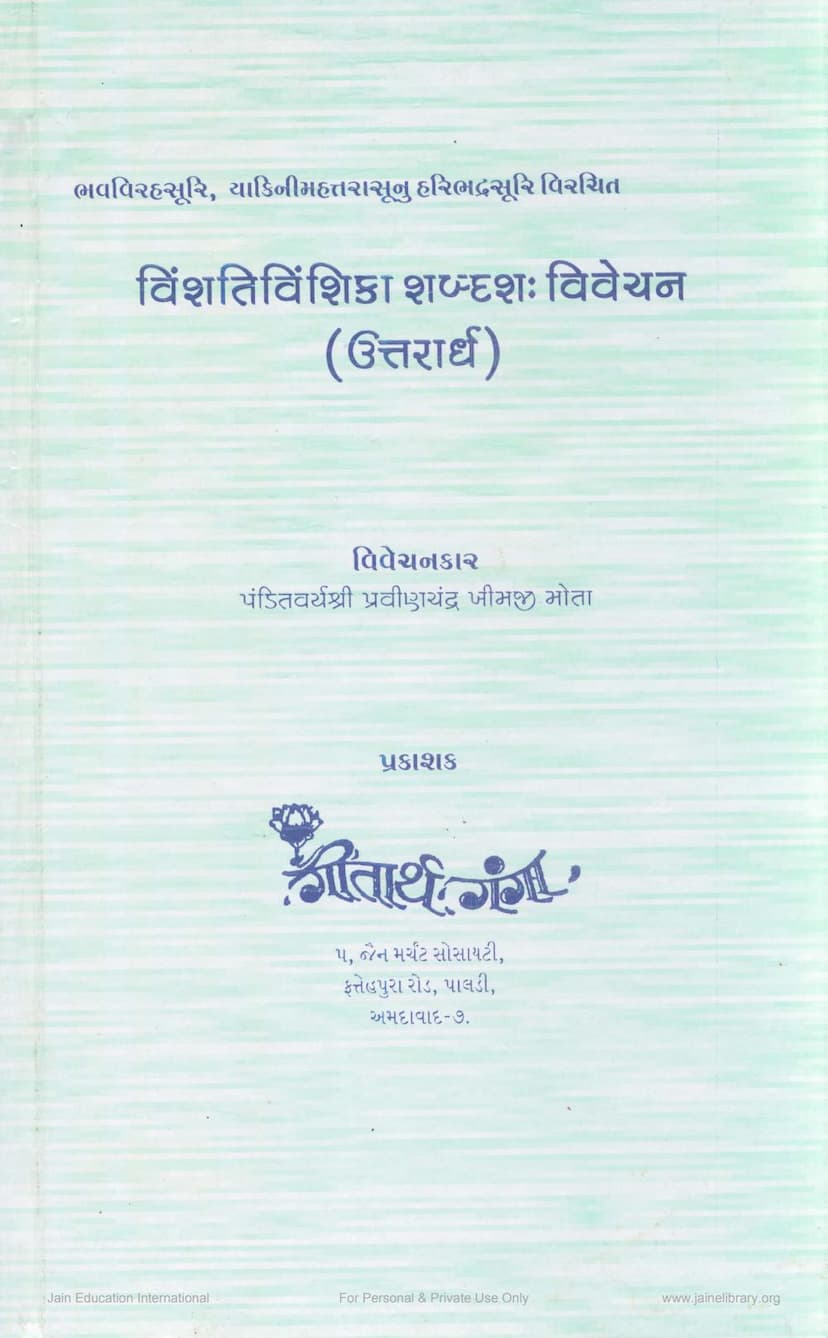Vinshati Vinshika Shabdasha Vivechan Uttararddha
Added to library: September 2, 2025

Summary
Here's a comprehensive summary of the Jain text "Vinshati Vinshika Shabdasha Vivechan Uttararddha," based on the provided pages:
Book Title: Vinshati Vinshika Shabdasha Vivechan Uttararddha (विंशति विशिष्ठा शम्शः विवेयन - उत्तरार्ध) Author(s) of Commentary: Pandit Pravinchandra Khimji Mota (पंडितवर्यश्रीप्रवीणचन्द्रखीमजीमोता) Original Author: Acharya Haribhadrasurishvarji Maharaj (आचार्यश्रीहरिभद्रसूरीश्वरजीम.सा.) Publisher: Gitarth Ganga (गीतार्थगंगा) Subject: The text is a detailed, word-for-word commentary (Shabdasha Vivechan) on the Uttararddha (later half) of Acharya Haribhadrasurishvarji's "Vinshati Vinshika" (a work comprising twenty chapters or "vinshikas"). This commentary delves into the profound spiritual concepts and practices outlined in the original text.
Overall Purpose and Publisher's Vision: The publisher, Gitarth Ganga, aims to analyze and elaborate on the profound philosophical elements embedded within Jain scriptures, authored by esteemed preceptors like Acharya Haribhadrasurishvarji and Upadhyay Yashovijayji. Their goal is to assist the Jain Sangh in achieving a comprehensive understanding of various entities. This particular book is presented as a supplementary activity to their primary work of publishing detailed analyses of scriptures. The publisher acknowledges the demand from curious seekers for publications of lectures and commentaries by learned scholars like Pandit Pravinbhai Mota.
Content Summary (Based on the "Praveśak" - Introduction): The commentary covers the latter ten "vinshikas" (chapters) of the original work, which likely detail advanced spiritual practices and philosophical concepts beyond the initial ten which might have focused on foundational principles. The introduction provides a glimpse into the content of each of the remaining vinshikas:
- 11th Vinshika (Yati Dharma Vinshika): Focuses on the ten specific virtues or duties (Dharma) of an ascetic (Yati). It delves into the nuances of these virtues, such as the five types of forgiveness (Kshama) and why certain virtues are exclusively applicable to monks and not lay followers. It also discusses concepts like "lokasanjna" (worldly consciousness) and the true nature of chastity (Brahmacharya).
- 12th Vinshika (Shiksha Vinshika): Deals with the specific training and disciplines (Shiksha) that an ascetic undertakes after initiation. It explains how these disciplines, even more than the happiness of a Chakravarti (emperor), lead to profound bliss and distinguish material happiness from spiritual well-being. It outlines how these disciplines are practiced through various types of "anushthans" (practices) leading to detachment.
- 13th Vinshika (Bhiksha Vinshika): Details the method of alms-receiving (Bhiksha) for an ascetic, including the 42 defects related to alms, food preparation, and living spaces. It explains how adherence to these principles leads to spiritual purity and ultimately liberation.
- 14th Vinshika (Bhiksha Shuddhi - Possibly Antaraya Linga Vinshika): Focuses on the meticulous awareness and vigilance required during the act of alms-seeking, with a mention that only 6 verses of this section are available.
- 15th Vinshika (Alochanā Vinshika): Explains the process of confession or self-criticism (Alochanā) for rectifying spiritual lapses, emphasizing the importance of choosing the right guru for confession and the correct method of confession to ensure spiritual progress.
- 16th Vinshika (Prāyashchitta Vinshika): Discusses ten types of expiation or penance (Prāyashchitta) and their purpose in purifying the soul. It addresses the question of why penance is necessary even after sincere confession and outlines how different penances apply to different transgressions.
- 17th Vinshika (Yoga Vinshika): Explores the concept of "Yoga" as the practice that integrates all aspects of a monk's life towards liberation. It describes the five types of yoga and their further subdivisions, emphasizing how these practices lead to ultimate liberation.
- 18th Vinshika (Kevalajñāna Vinshika): Delves into the nature of Omniscience (Kevalajñāna), clarifying the distinction between knowledge and perception, the characteristics of an omniscient being, and refuting misconceptions about the form of Kevalajñāna.
- 19th Vinshika (Siddha Vibhakti Vinshika): Introduces the concept of Siddhas (liberated souls) and their classification into fifteen types. It addresses the debate regarding the possibility of female liberation and establishes the equality of all Siddhas in their ultimate state of bliss.
- 20th Vinshika (Siddha Sukha Vinshika): Focuses on the unparalleled bliss of the Siddhas, explaining how this bliss is attainable through reason, scriptural evidence, and logic, and how it inspires spiritual endeavor.
Commentary Style: Pandit Pravinchandra Mota's commentary is described as "Shabdasha Vivechan," meaning it provides a word-for-word explanation. The author acknowledges that the original teachings of Acharya Haribhadrasurishvarji are profound and concise, and his commentary is an attempt to elaborate on them to the best of his understanding, seeking correction from other learned individuals.
Key Themes Elaborated: The introduction highlights the detailed explanations of various aspects of Jain asceticism, including:
- Yati Dharma: The fundamental duties and virtues of monks.
- Shiksha: The training and disciplines undertaken by monks.
- Bhiksha: The strict rules and awareness surrounding alms-receiving.
- Alochanā and Prāyashchitta: The processes of confession and penance for spiritual purification.
- Yoga: The integration of life's activities towards liberation.
- Kevalajñāna: The state of omniscience.
- Siddha: The nature and states of liberated souls and their bliss.
This commentary aims to provide a thorough and accessible understanding of these complex Jain doctrines for the benefit of the spiritual seeker.